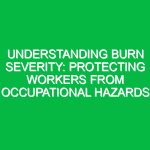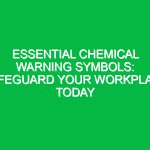Introduction
In the realm of health, safety, and environment (HSE), understanding “chemical meaning” is pivotal. This term encapsulates the significance of chemical substances, their interactions, and their implications for human health and environmental safety. As industries evolve, the importance of chemical safety grows, necessitating a profound comprehension of chemical meaning to mitigate risks and enhance workplace safety. This article delves into the depths of chemical meaning, exploring its relevance in the HSE domain, while offering insights, best practices, and real-life examples to illuminate its importance.
What is Chemical Meaning?
Chemical meaning refers to the inherent properties, behaviors, and implications of chemical substances, particularly in relation to human health and the environment. It encompasses understanding how chemicals interact with biological systems, the potential hazards they pose, and the regulatory frameworks governing their use. In the HSE context, this understanding is crucial for identifying risks, implementing safety measures, and ensuring compliance with legal standards.
To illustrate, consider the example of benzene, a common industrial chemical. Its chemical meaning encompasses not only its properties as a solvent but also its classification as a carcinogen. This dual understanding informs safety protocols, such as the necessity for proper ventilation and personal protective equipment (PPE) when handling benzene. By unlocking chemical meaning, organizations can foster a safer working environment and protect public health.
The Key Aspects of Chemical Meaning in HSE
1. Understanding Chemical Properties
A thorough understanding of chemical properties is the foundation of chemical meaning. These properties include physical characteristics such as boiling point, solubility, and reactivity. Knowledge of these properties helps predict how chemicals behave in various situations. For instance, a chemical with a low boiling point may pose a risk of vaporization and inhalation, necessitating specific safety measures such as fume hoods or gas detectors.
2. Risk Assessment and Hazard Identification
Risk assessment is an essential component of HSE practices. Identifying hazards associated with chemical substances allows organizations to implement appropriate control measures. For example, the Globally Harmonized System of Classification and Labeling of Chemicals (GHS) provides a standardized framework for classifying chemicals based on their hazards. Understanding the chemical meaning behind these classifications enables safety professionals to develop effective risk management strategies.
3. Safety Data Sheets (SDS)
Safety Data Sheets are critical documents that provide detailed information about chemicals, including their properties, hazards, handling instructions, and emergency response measures. Each SDS follows a standardized format, allowing for easy access to vital information. Familiarity with the chemical meaning of the information contained in an SDS empowers employees to handle chemicals safely and respond effectively in emergencies. For instance, an SDS for a corrosive substance will outline the necessary PPE, first aid measures, and spill response procedures.
4. Regulatory Compliance
Chemical meaning is deeply intertwined with regulatory compliance. Various regulations govern the use, storage, and disposal of hazardous substances, including the Occupational Safety and Health Administration (OSHA) standards in the United States and the Registration, Evaluation, Authorisation and Restriction of Chemicals (REACH) regulation in Europe. Understanding the implications of these regulations helps organizations avoid legal penalties and ensure a safe working environment. For instance, compliance with OSHA‘s Hazard Communication Standard requires employers to inform and train employees about chemical hazards, which is rooted in the understanding of chemical meaning.
5. Environmental Impact
Another significant aspect of chemical meaning is its environmental impact. Chemicals can have far-reaching consequences on ecosystems and human health. For example, heavy metals such as lead and mercury can contaminate soil and water, posing risks to wildlife and humans alike. Understanding the chemical meaning behind these substances allows for the implementation of proper waste management and pollution prevention strategies. Companies that prioritize environmental safety can employ practices such as recycling, waste reduction, and the use of green chemistry to minimize their ecological footprint.
Best Practices for Enhancing Chemical Safety
1. Training and Education
Training employees on the chemical meaning of substances they work with is paramount. Regular safety training sessions should cover topics such as hazard recognition, proper handling techniques, and emergency response procedures. For instance, an oil and gas company implemented a comprehensive training program that included hands-on exercises with safety equipment, resulting in a 30% decrease in chemical exposure incidents.
2. Implementing a Chemical Management System
A robust chemical management system is vital for tracking chemical inventory, ensuring proper storage, and maintaining up-to-date SDS. This system can include software solutions that facilitate easy access to information and automate compliance reporting. A manufacturing facility that adopted such a system reported improved efficiency in managing hazardous materials and significantly reduced the likelihood of chemical accidents.
3. Regular Audits and Inspections
Conducting regular audits and inspections of chemical storage areas and usage practices is essential for identifying potential hazards and non-compliance issues. These inspections should be thorough and documented, providing a clear record of compliance efforts. For example, a laboratory performing quarterly inspections found that proactive measures led to the early identification of leaks in chemical storage containers, preventing potential spills and contamination.
4. Emergency Preparedness
Developing an emergency response plan that addresses potential chemical spills or exposure incidents is crucial for ensuring employee safety. This plan should include clear procedures for evacuation, containment, and reporting. Real-life scenarios, such as a chemical spill during transportation, highlight the importance of preparedness. A logistics company that implemented a comprehensive emergency response plan was able to contain a hazardous material spill swiftly, minimizing environmental damage and ensuring employee safety.
Potential Hazards and Risks Associated with Chemicals
Understanding the potential hazards associated with chemicals is a critical component of chemical meaning. Chemicals can be classified into various categories, each with specific risks:
- Toxicity: Some chemicals can cause serious health effects upon exposure, including respiratory issues or organ damage.
- Flammability: Flammable chemicals can ignite easily, posing fire hazards in workplaces.
- Corrosiveness: Corrosive substances can cause severe damage to skin and materials.
- Environmental Hazards: Certain chemicals can harm ecosystems, leading to long-term ecological damage.
Recognizing these hazards requires a commitment to ongoing training, risk assessment, and adherence to safety protocols. For example, a construction site that routinely evaluated the risks associated with the chemicals used in their processes reported a significant decrease in accidents related to chemical exposure.
Regulations and Standards Impacting Chemical Meaning
Various regulations govern the management of chemicals in the workplace, significantly impacting chemical meaning. Some key regulations include:
- Occupational Safety and Health Administration (OSHA): OSHA sets standards for the safe handling and use of hazardous chemicals, requiring employers to provide training and safety information.
- Environmental Protection Agency (EPA): The EPA regulates the use and disposal of hazardous substances, promoting practices that protect human health and the environment.
- Globally Harmonized System (GHS): The GHS provides a standardized approach to classifying and labeling chemicals, facilitating communication about hazards.
Understanding the implications of these regulations helps organizations navigate compliance and adopt best practices for chemical safety. For instance, a pharmaceutical company that adhered to GHS guidelines was able to improve its labeling practices, ensuring that employees were well-informed about the hazards of the chemicals they handled.
Conclusion
In conclusion, unlocking chemical meaning is a fundamental aspect of promoting health, safety, and environmental sustainability. By understanding the properties, risks, and regulatory requirements associated with chemicals, organizations can implement effective safety measures and foster a culture of safety. This knowledge not only protects employees but also contributes to the overall well-being of the community and the environment. As industries continue to evolve, the significance of chemical meaning in HSE practices will only grow, urging professionals to prioritize safety and compliance in their operations. Encouraging ongoing education and proactive measures can lead to a safer future for all.


